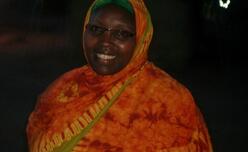Dadaab, Kenya - Today marks the International Day for the Elimination of Violence against Women and the start of 16 Days of Activism against Gender Violence. International Rescue Committee grants intern Jane Yang writes about how the IRC protects and empowers women who have made the dangerous trip from Somalia to a refugee camp in northeastern Kenya.
As the sun sets over Dadaab, the world’s largest refugee camp, my IRC colleague Ruth Kimaathi happily takes time out after a long day to sip milky Kenyan tea and talk with me about her job: counselling courageous women who have endured conflict and famine in Somalia.
“Working with these women gives me the energy to stay motivated every day,” she says.

Ruth, a mother of three grown children, joined the IRC in May after five years with an organisation that assists survivors of sexual violence in Kenya’s capital, Nairobi. She says that a trip to the Democratic Republic of Congo, where rape is often used as a weapon, inspired her to focus her career on helping women in war zones.
Ruth lives in a tent squeezed alongside those of other IRC aid workers in Hagadera, one of six sites that make up the sprawling Dadaab camp. Built in 1991 to shelter 30,000 refugees fleeing Somalia’s civil war, Hagadera now houses 140,000. The camp has grown dramatically as escalating violence and the region’s worst drought in decades have forced tens of thousands Somalis from their homes.
I listened as Ruth described a hidden side effect of the famine: growing violence against women and girls.
According to the United Nations, nearly 8 in 10 refugees arriving in Dadaab are female. After risking attack on the dangerous journey from Somalia, Ruth told me, many of them find that Dadaab is far from being the refuge they hoped for. They have no option but to wait for help on the outskirts of the overflowing camp, rigging up sheets and branches for shelter.
These makeshift settlements lack clean water, latrines or even security -- women risk being raped when they go out to collect firewood for cooking and as they sleep at night. And as more and more refugees arrive in Dadaab and competition for basic services grows, some women are even forced to engage in “survival sex” — selling their bodies for food and other necessities.
Every day, Ruth works with women and adolescent girls who have taken the first courageous step to seek help for rape, sexual exploitation, domestic violence, forced marriage and other abuses commonly experienced by Somali women.
Ruth and her colleagues ensure that rape survivors receive the medical attention and emotional support they need, helping them to regain their strength and self-confidence. She says that her job is to listen to their stories, then provide information about available services, offer counselling, and talk with them about which course of action they wish to pursue. She lets them know the IRC is there to help them seek justice.
A fearless advocate for women and girls in Dadaab, Ruth was also the main force behind a new initiative to protect them from sexual attacks while they collect firewood outside the camp.
Partnering with camp community leaders, Ruth set up a system of escorted trips to gather firewood. Now women go out in groups at scheduled times each week, accompanied by men from the camp for additional protection from attacks. Many women and girls have told Ruth they feel much safer since the service began in September.
For Ruth, her work to protect and empower women doesn’t stop there. She is also looking for ways to help women become financially independent. Many of the women in Dadaab have become the sole providers for their families after their husbands died or remained behind in Somalia. Coming from a traditionally patriarchal society, Ruth says, these women need a lot of encouragement.
“We need to help them realise that even without a husband, they can run a household. They can raise a family.”’
In women’s centres the IRC has set up in Hagadera and the recently opened Kambioos site in Dadaab, Ruth and her colleagues are teaching refugee women how to take newly-learned skills in tie-dying fabric, sewing clothes, and drawing henna and turn them into sustainable businesses.
Helping these women rebuild their lives is a process that takes time, Ruth says — but it’s time well-spent. She says she is proud to have been accepted into Dadaab’s Somali community.
“The Somali women have even given me a new name in their language: Lul. It means ‘diamond.’”
Beaming as she modeled a beautiful tie-dyed dress made by one of her students, Ruth sparkled like the gem she is.